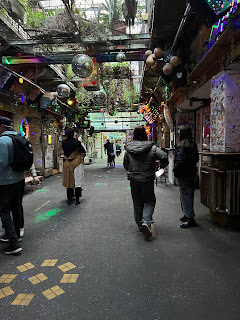Jewish Quarter Walking Tour in Budapest
Friday, October 27, 2024
Today, I joined an insightful walking tour of Budapest’s Jewish Quarter, where centuries of Jewish history unfolded before us—a story of resilience, vibrancy, and tragedy. Once home to one of Europe’s largest and most active Jewish communities, Budapest’s Jewish population settled here as early as the 13th century. They contributed immensely to commerce, education, and culture, enduring waves of anti-Semitism yet thriving in times of tolerance.
Jewish life in Budapest flourished during the Austro-Hungarian Empire’s “Golden Age” in the 19th century, when Jewish citizens found new freedoms and excelled across diverse fields, from science and finance to the arts. One of the tour’s highlights was the Dohany Street Synagogue, Europe’s largest synagogue, built during this period and still standing as a powerful symbol of Jewish heritage.
The tour also brought us face-to-face with the tragic events of World War II. During the German occupation in 1944, Hungary’s Jewish community faced the horror of the Holocaust. The Budapest Ghetto was established, confining tens of thousands of Jewish people in brutal conditions. Hungary’s delayed deportation process, informed by watching other nations’ horrific actions, led to a rapid and ruthless deportation of Hungarian Jews. An estimated 600,000 of Hungary’s 800,000 Jews perished, a stark reminder of the community’s devastating losses.
During the tour, we visited the Holocaust Memorial Center and stood in awe before the “ Emanuel Tree Memorial”, supported by Hollywood legend Tony Curtis. Driven by his Hungarian roots and Jewish heritage, Curtis co-founded Budapest’s Emanuel Foundation in the early 1990s, funding the striking weeping willow sculpture at the Dohany Street Synagogue. Each leaf bears a name of a Holocaust victim, symbolizing both grief and remembrance. This commitment to preserving Hungary’s Jewish history was incredibly moving.
(During yesterday’s tour of Budapest, I saw the heart-wrenching “Shoes on the Danube” memorial, honoring Jewish victims who were shot and thrown into the river by the fascist Arrow Cross militia.)
The tour continued to the Kazinczy and Rumbach Street Synagogues, two historically significant yet lesser-known sites. I was surprised to learn that Theodor Herzl, the father of modern Zionism, was from Budapest—a connection that deepened my understanding of the city’s role in Jewish history.
Our tour wrapped up with a visit to the lively Szimpla Kert, Budapest’s most famous ruin bar. This vibrant spot, set in an abandoned building, is a fascinating mix of creativity, history, and urban renewal.
Today’s tour offered a unique view of Budapest’s Jewish Quarter—a blend of Jewish heritage, turbulent history, and the area’s ongoing revival, from kosher restaurants to cafes and cultural centers. It was a testament to the resilience and lasting legacy of Budapest’s Jewish community.


























